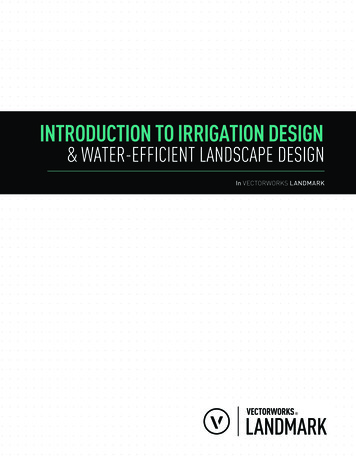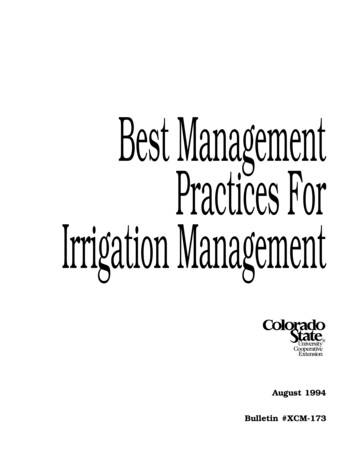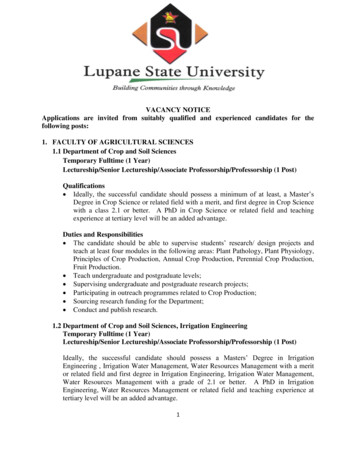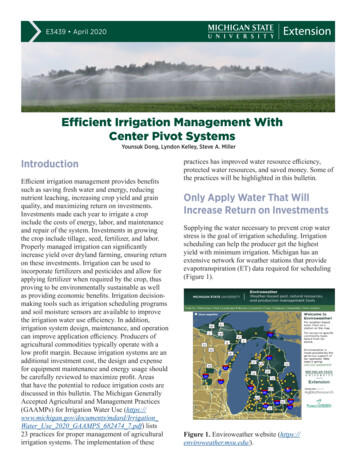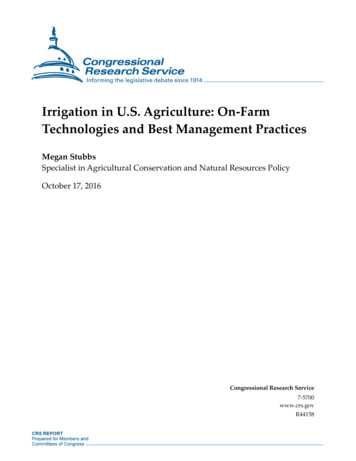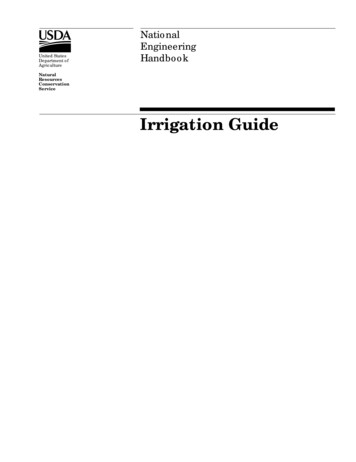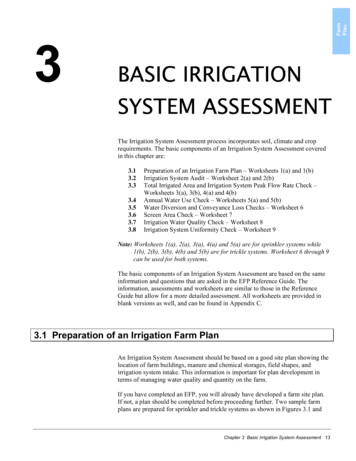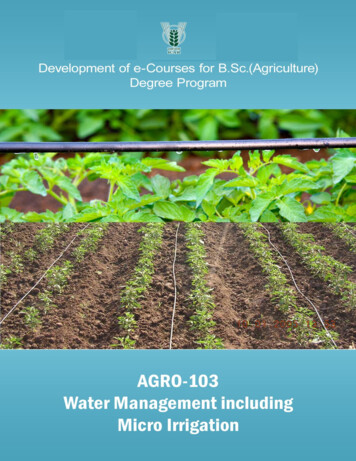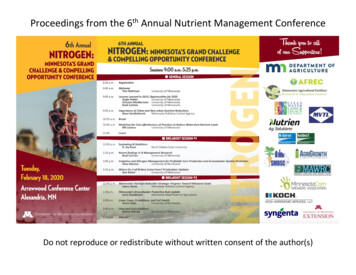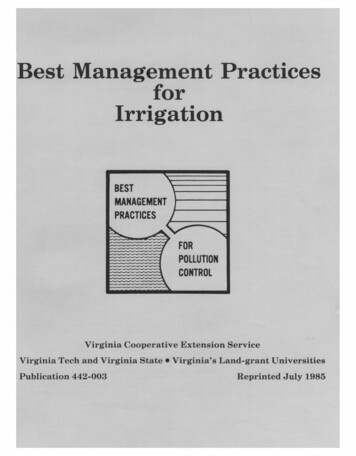
Transcription
Best Management LLUTIONCONTROLVirginia Cooperative Extension ServiceVirginia Tech and Virginia State Virginia's Land-grant UniversitiesPublication 442-003Reprinted July 1985
j .()S(f6 A rtt, l/Jf -603VPtf\o. s, , ,Best Management PracticesforIrrigationAbatement of Nonpoint-sourcePollution from Agricultural IrrigationbyJ. David Lambert, Extension AssistantandB. B. Ross, Extension Agricultural EngineerDepartment of Agricultural EngineeringCollege of Agriculture and Life SciencesVirginia Polytechnic Institute and State UniversityBlacksburg, Virginia 24060Virginia Cooperative Extension Service programs. activities. and employment opportunities are available to all people regardless of race . color. religion . sex .age. national origin . handicap . or political affiliation . An equal opportunity/ affirmative action employer.Issued in furtherance of Cooperative Extension work . Acts of May 8 and June 30. 1914 . and September 30 . 1977 . in cooperation with the U.S. Department ofAgriculture . Mitchell R. Geasler. Director. Virginia Cooperative Extension Service . and Vice Provost for Extension , Virginia Polytechnic Institute and StateUniversity . Blacksburg . Virginia 24061 : Clinton V. Turner . Administrator. 1890 Extension Program . Virginia State University . Petersburg . Virginia 23803(2)
IntroductionWe ALL need Clean Water. It is essential tolife-to our social, cultural, and economic wellbeing. Clean water is especially important toagricultural producers who use it for wateringlivestock, cleaning equipment, processing, andirrigating their crops. Increased concern for thedeteriorating quality of our nation's waters led tothe passage of the Federal Water PollutionControl Act Amendments of 1972 and the CleanWater Act of 1977. These laws require each stateto plan for the control or abatement of nonpointsource pollution.Nonpoint-source pollution results from runoffsnow melt, or groundwater seepage fro industrial, municipal, and agricultural sites.Nonpoint-source pollution often goes unnoticed;however, it is extremely widespread and makes asignificant contribution to our overall waterpollution problem.All forms of agricultural production cancontribute to nonpoint-source water pollution.Livestock producers must be concerned withpreventing animal wastes from reaching waterbodies; crop producers are faced with soil erosionand sedimentation as their main concern.Fertilizers, pesticides, chemicals, wastes andsediment may be carried into surface waters byrunoff or seep into groundwaters when improperlymanaged. Noticeable effects of these pollutantsinclude nutrient enrichment which causes algalblooms, fish kills resulting from chemicalpoisoning or reduced oxygen levels, andsmothering of aquatic organisms by sediment.Figure 1preparations to control storm runoff, they cantake positive measures to prevent irrigation fromcontributing to nonpoint-source pollution. Theimpact of falling irrigation water, like rainfall,dislodges soil particles. If the water is applied at arate exceeding the soil's infiltration rate, or ifmore water is applied than the soil can containthe resulting runoff can carry the dislodged soiiparticles away (Figure 2). If the excess application continues, the quantity and velocity of runoffincreases to provide sufficient energy fordislodging and transporting additional soilparticles. Uncontrolled, runoff cuts rills and thengullies as it carries away valuable topsoil.In addition to creating water pollutionproblems due to sedimentation, nutrient enrichment, and chemical poisoning, irrigation runoffrepresents wasted water and energy.Another factor to be considered in addition toproper application of water is the degree andlength of slope. Steeper slopes increase thevelocity of runoff; long slopes allow largerquantities of water to accumulate. Reducing theBest Management PracticesVirginia has chosen to approach the problem ofnonpoint-source pollution through · voluntaryprograms and education of its citizens. Producersare encouraged to adopt Best ManagementPractices, often called BMPs. BMPs are soundcommon-sense conservation practices that wilienable improved water quality to be realized.BMPs, which include management, structural,and agronomic measures, take into accountexisting operations so that productivity ismaintained, and even enhanced in some cases.Runoff from IrrigationIrrigators encounter the same nonpoint-sourcepollution problems that all crop producers have.In sprinkler irrigation, which accounts for nearlyall of the irrigated acreage in Virginia, irrigatorsare faced with additional nonpoint-sourcepollution potential due to the irrigation itself(Figur 1).While irrigators can only make limitedFigure 2(3)
quantity and velocity of runoff is a basicprinciple of erosion control. This can beaccomplished by utilizing appropriate combinations of agronomic and structural BMPs.The physical properties and condition of thesoil will also influence the extent of soil erosion.Although soil type cannot be changed, carefulcultural practices that promote good soilstructure can increase erosion resistance. Finetextured soils are particularly susceptible torunoff and erosion because of limited infiltrationand seepage rates. Sandy soils, on the otherhand, are vulnerable to nutrients and chemicalsbeing leached into groundwater because theyhave considerably higher seepage rates andlower water holding capacity.Soil cover also affects the degree of runoff anderosion that may occur. Cover protects the soil byreducing the impact of falling irrigation orraindrops and by the slowing of runoff velocity.Cover may also increase infiltration capacity andimprove soil structure.Figure 3Design BMPsThe design of the irrigation system can have asignificant effect on the potential for nonpointsource pollution as well as operating efficiencyand costs. One of the first considerations whenselecting an irrigation system should be itsadaptability to the soil and terrain. For example,because of high application rates, low-pressurecenter-pivots are best suited to flat terrain andsoils with high infiltration rates (Figure 3).Higher-pressure center-pivots, on the other hand,may be adaptable to rolling terrain because oflo er application rates.Because of high application rates and therelatively large water droplet sizes associatedwith big-gun irrigation, the erosive potential ishigh. Therefore, these systems are most suited tosandy soils and flat terrain where runoffpotential is less.Portable pipe and solid-set sprinkler-systemdesign is adaptable enough to accommodate awide range of soil conditions and terrain. Theright combination of pipe spacing, sprinklerheads, and pumping capacity can limit therunoff-producing potential of the system.Trickle and other low-volume systems areparticularly well suited to steeper slopes andheavier soils since runoff is practically eliminated. Because of high water-use efficiency, thesesystems are ideal where water supplies arelimited and runoff potential is high.It is the responsibility of the irrigation systemdesigner to select an appropriate system to meetFigure 4the needs of the crop and to consider soil andwater conservation. Application rates are, for themost part, set by this design. Therefore, if thedesign application rate exceeds the existinginfiltration rate of the soil, runoff will occur.Structural changes can be made after installationof a system to alter application rates. An exampleof this is the replacement of sprinkler heads andpossibly the pumping unit. However, thesemodifications require redesigning the system andare always expensive.Relocating systems to field and crop conditionsdifferent than those for which they were designedcan often lead to runoff problems. An irrigationdesigner or consultant should be contacted whenbuying a used system or relocating one to assurethat its design application rate is appropriate forthe new location. A consultant should also becontacted when there is excessive runoff from anexisting system (Figure 4).Management BMPsConscientious management of both the systemand the irrigation water is as important inpollution control as proper design. In addition,good management almost always translates into(4)
water and energy savings, thereby increasingproductivity per dollar invested.System ManagementProducers should develop a familiarity withtheir systems in order to insure proper andefficient operation. Periodic observation andinspection of the system, as well as a regularmaintenance program, will establish thisfamiliarity and identify problems (Figure 5).The amount of water applied should bedetermined by averaging the depth of watercollected in several rain gauges or straight-sidedcans that have been distributed throughout theirrigated field. This information enables theproducer to verify that the expected amount ofwater is being applied.In the case of self-propelled systems, such ascenter-pivots and travelling guns, the travelspeed should be checked periodically. Forexample, the speed of a hose-tow travelling gunshould be observed at the beginning, middle, andnear the end of the travel lane to assure properspeed compensation as the hose is wound on thedrum (Figure 6).Periodic inspection of pumps, controls, pipes,and sprinklers is also advisable (Figure 7). Whenthese components wear out, design dischargemay be affected. Maintaining records of fuelconsumption and pressure gauge readings willalso help operators foresee developing problems.Prompt attention to problems such as line breaksand leaking seals will prevent needless soilerosion. Of course, nothing can substitute forregularly scheduled maintenance.Properly maintained equipment is not, however, all that must be considered to assure properapplication. For example, if the big gun on atraveller is left opera ting too long whilestationary, such as at the end of its travel lane,this area will receive excessive amounts of water.Simple devices, such as shut-off timers, areavailable to eliminate this type of problem.Operators of big guns should also be aware thata distribution pattern smaller than a full circlewill proportionately increase the rate of waterapplied. For example, the application rate isdoubled when irrigating with a half-circle ratherthan a full-circle pattern. A partial-circle patternshould, therefore, be used only where necessary.Nighttime irrigation can result in substantiallyhigher irrigation efficiencies due to reducedevaporation. For example, a sprinkler systemwhich operates at 70 Yti efficiency during the daymay operate as high as 90% efficiency at night.Therefore, a larger amount of water is availablefor runoff.Figure 5Figure 6Figure 7(5)
In situations where infiltration rates arerestricted, the amount of water needed may beapplied in two applications. This may requiremaking two passes with a self-propelled system,or providing a delay period between two separateapplications with a stationary system.Water ManagementThe primary objective of water management isto apply the right amount of water at the righttime while maintaining the higher yieldsattributable to irrigation. Irrigation schedulingcan result in significant savings in irrigationtime, labor, and water. It can also translate into adirect savings of energy and maintenance costsand extended life, through reduced use, of theirrigation system. By carefully managing theamount of water applied, leaching of nutrientsand erosion can be reduced. Plants susceptible todisease caused by excessive moisture may alsobenefit. In other words, irrigation schedulingincreases profits and, at the same time,contributes to nonpoint-source pollution abatement.Proper irrigation scheduling requires monitoring the soil moisture conditions. In addition, it isimportant to know the waterholding capacity ofthe soil in determining the amount of water to beapplied.Attention should also be given to how the waterneeds of the crop depend upon the stage ofgrowth. For example, corn is not as susceptible tomoisture stress during its early vegetative stageas it is during tasseling and silking.Impending weather conditions should, ofcourse, be considered. In order to providesufficient storage capacity in the event thatrainfall follows irrigation, the soil should not becompletely saturated.Plant wilting has been used extensively forirrigation scheduling in the past, however, it hasbeen shown that potential yields may havealready been reduced before reaching this point.Traditional methods, such as "soil feel" and soilprobe techniques, can be used with reasonablesuccess after the producer has gained considerable experience.Three modern techniques for irrigationscheduling are recommended for Virginia'sconditions. These include the use of tensiometers,evaporation pans, and moisture accountingmethods. It is further suggested that two methodsbe used concurrently as checks on each other.1) The tensiometer is an instrument whichmeasures the increased tension, or suction, inthe soil as it dries (Figure 8). VirginiaCooperative Extension Service (VCES)Figure 8agents can help producers interpret readingsin terms of plant-available water.2) The water level in an evaporation panfluctuates with atmospheric evaporation,rainfall, and irrigation. When the water leveldrops to a pre-determined point, dependingupon the soil and crop, irrigation shouldbegin.3) The moisture accounting method, alsoreferred to as the bookkeeping or checkbookmethod, requires that measurements ofrainfall and irrigation, and estimates ofevapotranspiration, be added and subtracted;and a soil moisture balance be maintained.When a predetermined water level is reached,irrigation should begin. This method issuitable for programming on a farmcomputer.Agronomic and Structural BMPsIn addition to proper initial design, maintenance, and management of the irrigation system,producers can sometimes benefit from utilizingconservation cropping practices such as contourtillage and no-till planting. Contour tillagereduces runoff velocity and increases infiltration,thereby l·educing runoff. In addition to runoffcontrol, no-till cropping also offers considerablesavings in time and energy; this translates intohigher profits (Figure 9). Reduced runoff due toconservation cropping means higher irrigationwater efficiency, less nutrients and chemicalslost, and, of course, reduced soil erosion.Diversions may be used in conjunction withother BMPs when runoff from areas abovecropped fields is causing erosion. The diversion,constructed at the upper edge of the cropped field,intercepts and channels erosive runoff around(6)
contain any spills which might occur.Likewise, care should also be taken whenfueling combustion-type power units nearwater supplies.3) Chemical application should be avoidedwhen wind could carry nutrients or chemicals into streams, lakes, or the irrigationpond.4) In addition to proper handling and storagepractices, producers should give specialattention to calibrating injection equipmentto assure that intended rates are applied tothe crop.5) Do not exceed the recommended rates ofeither chemicals or water; excessive amountswaste money and can easily be carried withrunoff or groundwater seepage into watersources.6) Weather conditions and soil moisturestatus should be considered whether theirrigation system or conventional methodsare used to apply fertilizers and chemicals. Inmost cases, applications soon before orshortly after rainfall or irrigation can greatlyincrease the potential for nonpoint-sourcepollution.Figure 9the field. Producers can also utilize grassed filterstrips, grassed waterways, terraces, and dropstructures to help control erosion problems.Carefully selected and implemented, combinations of management, agronomic, and structuralBMPs offer producers the means to increase or, atleast, maintain productivity while contributing toimproved water quality in Virginia.Fertigation and Chemigation BMPsProducers can utilize many types of irrigationsystems to safely apply fertilizers and chemicalsto their crops (Figure 10). A few guidelines willhelp assure that these materials do not becomepollutants.1) Injection systems should be designed toprevent any possibility of contaminatingwater supplies in the event of equipmentmalfunction. This includes the use ofappropriate check valves and anti-siphondevices to prevent backflow of fertilizer andchemicals into water bodies.2) Chemicals should be mixed and injected inareas that are located well away from waterbodies, and provisions should be made toOther ConcernsAdditional uses for irrigation systems, such asfrost protection, turf irrigation, and wastedisposal can also contribute to nonpoint-sourcepollution. However, these uses involve additionaldesign and management concerns which arebeyond the scope of this publication.ConclusionIf Virginia's voluntary approach to nonpointsource pollution is to be successful, all of us mustlook at our operations and ask, "Has myproduction contributed to nonpoint pollution?"Your local VCES agent can help you answer thisquestion.Technical assistance for the planning, design,and implementation of Best ManagementPractices is available from your DistrictConservationist at your local Soil and WaterConservation District office and from the SoilConservation Service.Now is the time to develop a feasible plan topreserve water quality for future generations ofVirginians. It is only through the concern andactions of all Virginia citizens, includingirrigators, that a reduction in nonpoint-sourcepollution and improved water quality can becomea reality.Figure 10(7)
Recommended ReadingThese publications in the BMP Series may beobtained from your Extension Agent:Best Management Practices for Tobacco Production, 4WCB6, January 1981;Conservation Tillage-A Best ManagementPractice, 4WCB7, January 1981;Best Management Practices in Agriculture andForestry, 4WCB1, January 1980;Terraces-A Best Management Practice, 390-408,October 1981;Best Management Practices for Row CropAgriculture, 4WCB3, June 1980;Integrated Pest Management-A Best Management Practice, 390-409, February 1982;Best Management Practices for Beef and DairyProduction, 4 WCB4, July 1980;Best Management Practices for Horticulture, 390410, November 1982.Best Management Practices for Swine Operations, 4WCB5, November 1980;DisclaimerCommercial products are named in this publication for information purposes only. The VirginiaCooperative Extension Service does not endorse these products and does not intend discriminationagainst other products which also may be suitable.(8)
rate exceeding the soil's infiltration rate, or if more water is applied than the soil can contain the resulting runoff can carry the dislodged soii particles away (Figure 2). If the excess applica tion continues, the quantity and velocity of runoff increases to provide sufficient energy for dislodging and transporting additional soil
